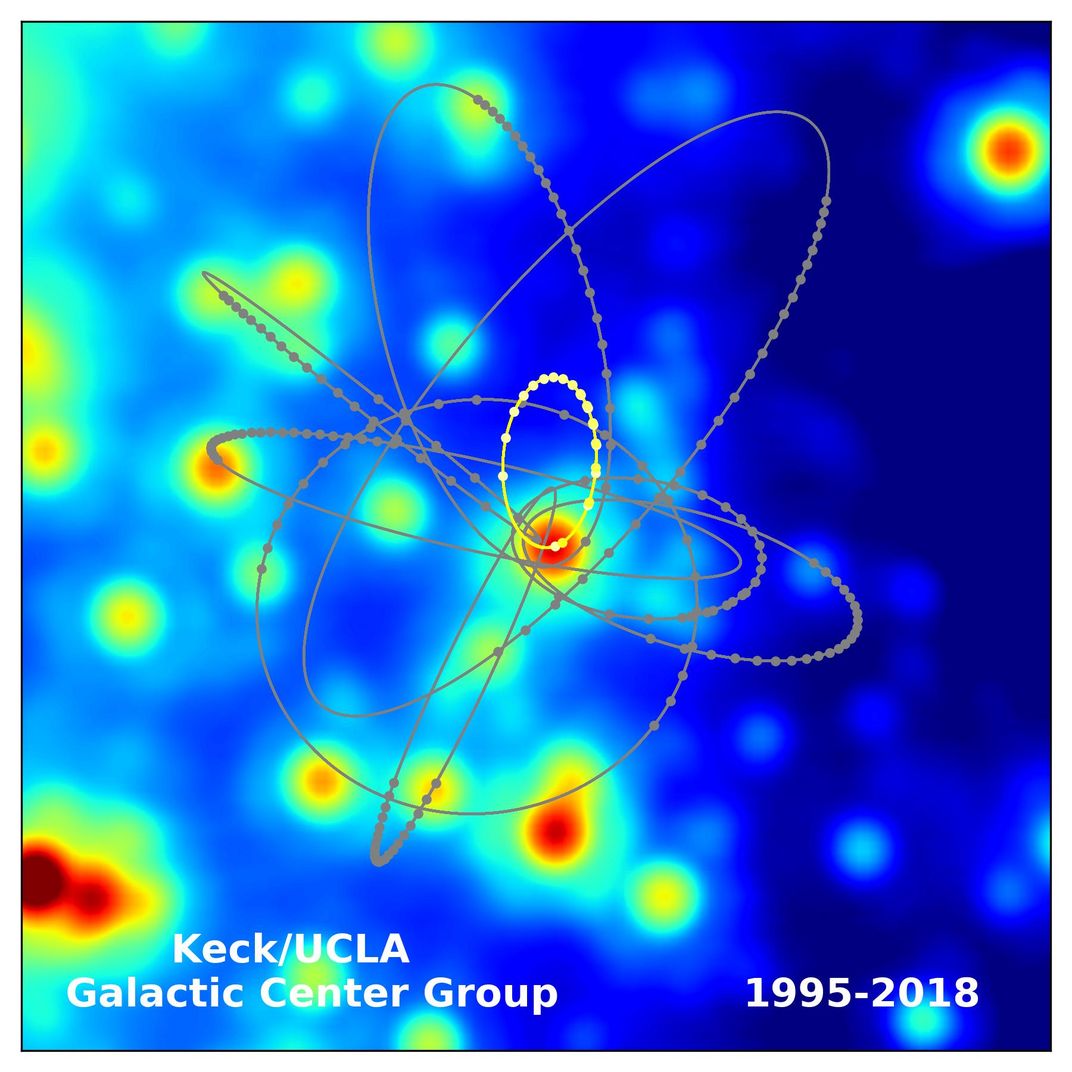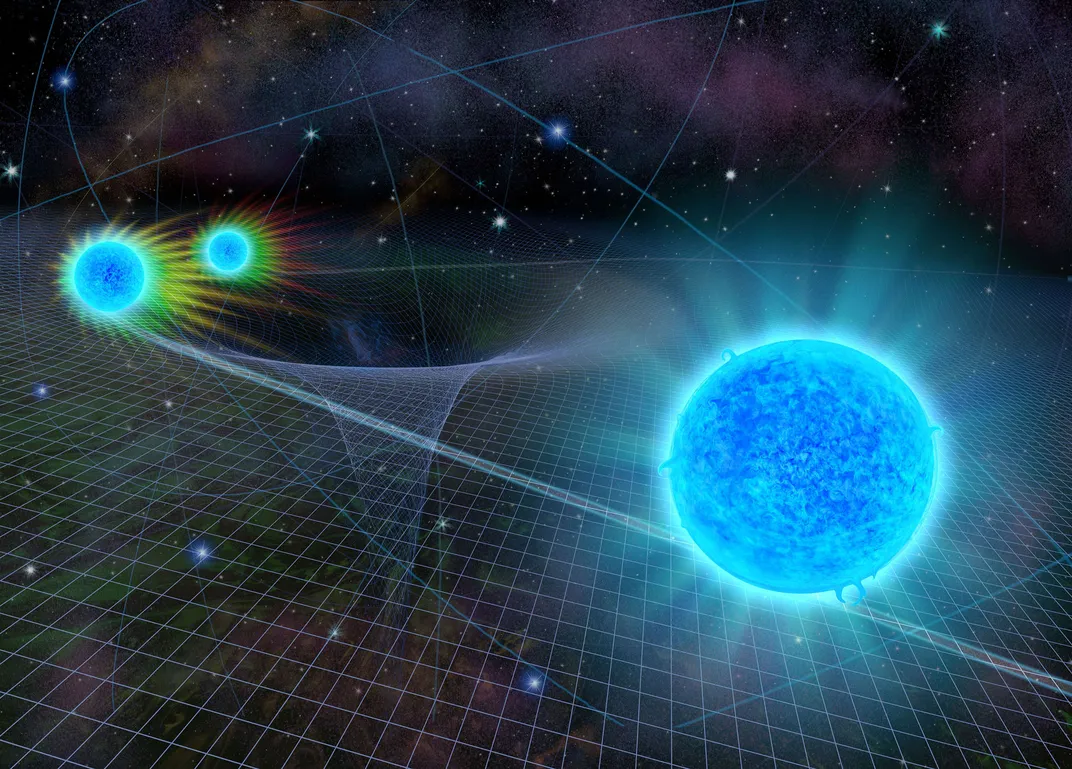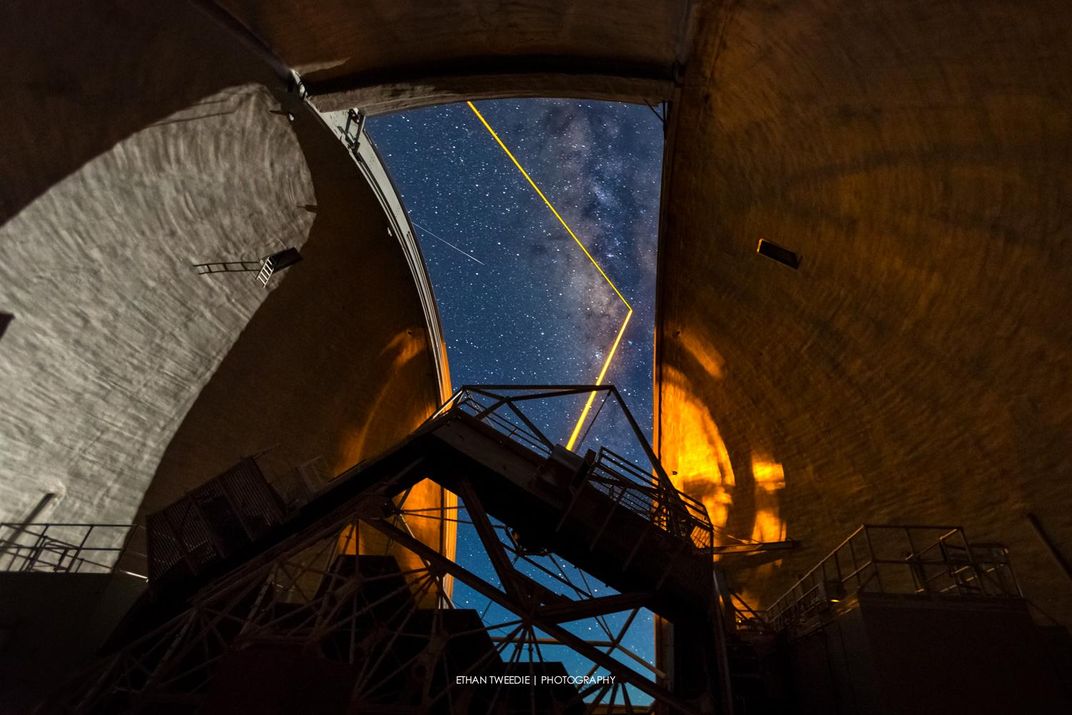A Star Orbiting in the Extreme Gravity of a Black Hole Validates General Relativity
The star S0-2 gets so close to the supermassive black hole at the center of the galaxy that it can be used to test our fundamental understanding of gravity
:focal(980x838:981x839)/https://tf-cmsv2-smithsonianmag-media.s3.amazonaws.com/filer/fe/67/fe6786cc-be25-4fca-b638-1856f3b02520/do7hr.jpg)
At the center of the Milky Way galaxy, nearly 26,000 light-years away, a cluster of stars circles close to the supermassive black hole known as Sagittarius A*. As these few dozen stars, called S-stars, approach the black hole—which is about four million times more massive than the sun—its immense gravitational force whips them around faster than 16 million miles per hour. In fact, the gravitational pull of Sagittarius A* is so intense that it warps the light from these stars when they stray too close, stretching the wavelengths toward the red part of the electromagnetic spectrum.
One star in particular, S0-2, gets so close to Sagittarius A* that astronomers have found it to be one of the best natural laboratories for testing the limits of our fundamental theory of gravity: Einstein’s general relativity.
For more than two decades, astrophysicists have been tracking the movements of S0-2 to better understand the workings of gravity and put Einstein’s theory to the test. By imaging the star’s position and measuring the spectrum of its light, researchers hope to determine whether S0-2’s orbit around the black hole matches the path predicted by general relativity. In a study published today in Science, an international team of astronomers reports that the star’s behavior agrees with Einstein’s theory of gravity, confirming that general relativity still holds up in the region surrounding a supermassive black hole—at least for now.
“You want to test the theory in as extreme as environment as you can … to essentially push the theory harder than what we might have predicted,” says Tuan Do, a research scientist at UCLA specializing in the galactic center and lead author of the study.

Einstein’s general theory of relativity describes the three dimensions of space and the one dimension of time as inherently bound up in a “fabric” of spacetime. Massive objects, like stars and black holes, warp this fabric to stretch distances and slow time, pulling surrounding objects toward them. We perceive this effect as gravity—an apple falling off a tree. But light is also affected by gravitational forces, bending as it moves through the warped spacetime around a massive object.
According to general relativity, supermassive black holes like Sagittarius A* create a large curve in spacetime, producing an extremely strong gravitational field. When a star moves close to such a black hole, photons of emitted light are pulled into the field, and the light that escapes and makes it to Earth must climb out of the black hole’s gravitational well. The result is that the observed light has lower energy—a lower frequency and longer wavelength—producing a redder spectrum. Scientists compare general relativity’s predictions of this effect, called gravitational redshift, to the measured wavelengths of incoming light from stars like S0-2 to test whether the theory holds true.
A number of factors other than gravity can influence redshift, however, including if an object is moving away or toward the observer. “The heart of the question is, basically, can you measure all of these other effects well enough that you can confidently say that what you’re seeing is a gravitational redshift, and not just some other way you can basically adjust the orbit of the star,” Do says.
S0-2 orbits Sagittarius A* every 16 years. In May 2018, it reached its closest point to the black hole, coming within 120 astronomical units (just over 11 billion miles) and traveling at just under three percent of the speed of light (around 18 million miles per hour). At this time, the redshift effect is particularly notable as the gravitational pull of Sagittarius A* grows stronger when the star moves closer. In March and September of the same year, the star also reached its points of maximum and minimum radial velocity, respectively, meaning it was moving fastest and slowest in relation to an observer on Earth. The redshift signals from these three events are crucial to mapping the shape of the star’s orbit where the effects of gravity are the most extreme.
“The redshift signal is strongest at the point of closest approach because it's closest to the black hole, but that's not where it’s the easiest to measure because what we are really sensitive to … is changes in the relative velocity, so you want to catch it on the rising and falling side of this signal,” Do says.

Supermassive black holes are puzzling playgrounds for testing physics because they don’t fit neatly into today’s dominant theories. “Black holes are both very massive and extremely compact, so it’s kind of where general relativity and quantum mechanics collide,” Do says. While quantum mechanics describes the smallest particles in our universe—a realm where gravity can usually be ignored—general relativity deals with massive objects that have immense gravitational fields. Some physicists expect that these two theories will come to a head at the very center of a black hole, where an immense mass is thought to be contained in an infinitely small volume, a point known as gravitational singularity.
“Almost all attempts to understand gravity at the quantum level, and to understand how it fits with other forces of nature, seem to suggest that general relativity is incomplete and must break down or deviate in some way, and strong gravity is where this would happen,” says Clifford Johnson, a theoretical physicist from the University of Southern California who was not involved in the study, in an email. “The neighborhood of black holes, both large and small, is increasingly becoming an observational arena for strong gravity … where we have a chance of seeing where general relativity breaks down, [and] if it does, possibly revealing physics of our universe, and more about the nature of space and time.”
The research team used a combination of telescope imaging and spectroscopy to map S0-2’s orbit. Since the atmosphere around Earth is always moving, blurring our view of the sky, they relied on adaptive optics and a technique called speckle imaging to capture a clear picture—essentially, they used a flexible mirror, warped thousands of times per second by actuators, and took snapshots of the sky to correct for atmospheric blurring.
“The Earth's atmosphere is great for humans, but bad for astronomy. ... It's like looking at a pebble underneath a river, and you're trying to measure the position of the pebble.” Do says. “Basically we’re trying to remove the twinkling in the stars.”

The researchers traced an orbit for S0-2 and compared it to predictions from the general relativity model and the simpler Newtonian physics model. The team found that the star was moving almost 450 thousand miles per hour faster than what Newtonian gravity would predict, and that the general relativity model was 43 thousand times more likely to explain their observations.
“Einstein’s general theory of relativity once again proves right, within the accuracy of the measurements,” says Nikodem Poplawski, a mathematician and physicist from the University of New Haven who was not involved in the new study. He also points out that the results support the existence of black holes as described by general relativity. “In addition to what was observed in April with the first picture of a black hole, now we have here more evidence that what’s inside our Milky Way is a supermassive black hole.”
Similar work reported last year also claimed that S0-2’s orbit followed general relativity’s predictions. However, these new results add extra evidence from an additional three months of data taken when the star was closest to Sagittarius A* and the redshift signal was the strongest, including the crucial third orbital event in September of last year.
“The possibility that you could measure general relativity at the galactic center has been around for a decade,” Do says. “To say that we can finally do it—this to me signals the start of an era of even more tests of gravity around the center of the galaxy and opens a lot of avenues for more science around the supermassive black hole.” Moving forward, the research team will continue tracking the motions of the S-stars, probing deeper into the mysteries of black holes and the physics that govern our universe.